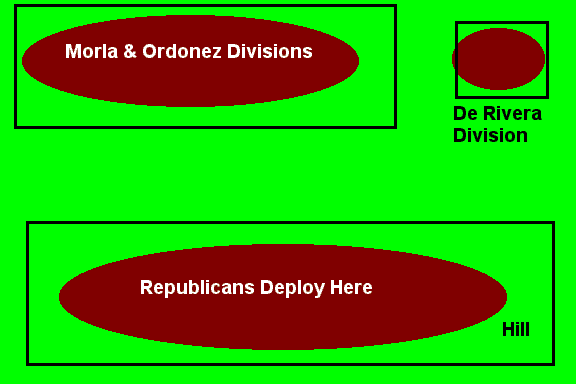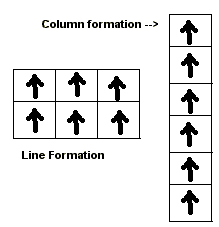
Historical Background: Jose de San Martin led the battle for independence against the Spanish in the southern part of South America. His efforts were instrumental in the liberation of Argentina and Chile. His greatest victory came in 1818 at the the Battle of Maipo in Chile. In this decisive battle he defeated the final Spanish offensive and secured the freedom of Chile.
Battle 1: This battle has not yet been playtested.
Building the Armies: Right now there aren't any 1/72 plastic soldiers designed for the Latin American wars of liberation. You can substitute Napoleonic era figures. Check out the Plastic Soldier Review to see the many figures that are available. Here are some paper soldiers you can print and use. Infantry, artillery crew, and cavalry are mounted two per base. Cavalry bases are 1.5" square, infantry and artillery crew bases are 3/4" x 1.5". Mounted commanders are based singly on 3/4" x 1.5" bases.
The Map: The battle was played on a 5' x 7.5' table. The two armies faced off from atop hills, with a flat valley between them. The hills must be modeled.
Deployment: Republican and Royalist forces deploy as shown on the map. The De Rivera Division was deployed on a hill on the extreme left of the Royalist army, some distance from the rest of main force. No unit can start closer than 18" from the enemy.

Orders of Battle: All units have six bases.
Republican Army (All units 6 bases)General Jose de San Martin (Overall Commander) Las Heras Division - Col.
Las Heras Alvarado Division - Col. Alvarado Reserve Division - Col. de
la Quintana |
Royalist Army (All units 6 bases)General Mariano Osorio (Overall Commander) Ordonez Division - Col. Ordonez Morla Division - Col. Morla De Rivera Division - Col.
de Rivera |
Turn Sequence:
1. Republicans Move
2. Republicans Shoot
3. Royalists Move
4. Royalists Shoot
5. Charges
6. Melees
 Formations: There are only two formations for infantry
- line and column. The names of these formations can be very confusing
for the students. At school, when they are told to "get in
line" they line up one behind the other, in what we call
column formation. With the kids I call the formations "firing
line" (like a firing squad), and "marching column."
Lines may be single or double rank, and may bend. Columns are
single company. Units may change formation at the start or end
of their movement, but can only change formation once per turn.
Cavalry stay in line formation at all times. Artillery don't have
formations.
Formations: There are only two formations for infantry
- line and column. The names of these formations can be very confusing
for the students. At school, when they are told to "get in
line" they line up one behind the other, in what we call
column formation. With the kids I call the formations "firing
line" (like a firing squad), and "marching column."
Lines may be single or double rank, and may bend. Columns are
single company. Units may change formation at the start or end
of their movement, but can only change formation once per turn.
Cavalry stay in line formation at all times. Artillery don't have
formations.
Movement: Infantry can move 6" if they are in line formation or 12" if they are in column formation. Cavalry and Commanders may move 12". Cannons can move 12" but may not fire on a turn when it was moved. A cannon which has moved and cannot fire should point away from the enemy. Cannons can pivot in place during movement and still fire. Units may not move within 1" of an enemy unit except when charging.
Shooting: Infantry that are in line formation and artillery that didn't move this turn may fire. Range is measured from the center of a unit to the nearest part of the target unit. Units may only fire to the front and may not fire through narrow gaps between friendly units. Roll one die per infantry base or two dice per cannon. The chart indicates the number needed for a hit. Remove one base for each hit rolled by the firing unit. It takes three hits in the same turn to remove a cannon. Note that you only use the 1" firing column when shooting at a charging unit. If a unit is reduced to a single surviving base then the last base is immediately removed. Units in column are good targets. Roll two extra dice when shooting at columns.
|
|
||||||||||||||||||||||||||||||||||||||||
Charges: Both sides may charge during the charge phase. If it matters the Republicans charge first. Cavalry can charge 12", infantry can charge 6". Cannons do not charge. A unit may not declare a charge unless it is in line formation and can reach an enemy unit. A player may measure to see if a unit is within charge range. One enemy unit must be chosen as the target of the charge. A unit that wishes to charge must first pass a morale check. If the unit fails morale nothing happens, it cannot charge this turn. If the unit passes its morale check then the target must pass a morale check. If the target fails it loses one base and immediately retreats 12", the charging unit is moved into the position vacated by the retreating target unit. If artillery is the target and it fails morale it is eliminated. If the target passes the morale check it has the option of firing at the chargers (assuming the unit is eligible to fire this turn) or counter charging. If the unit counter charges the two units meet in the middle and fight a melee. If the target decides to fire at the chargers it does so at a range of 1". If the charging unit survives the fire it moves into contact with the target and they fight a melee.
Morale Checks: If a unit has to take a morale check Roll one die and add any modifiers. If the roll is less than or equal to the number of bases (plus a commander if one is present), then it has passed. If the roll is greater then it fails. Cannons pass on a roll of four.
| Commander Present |
|
Melee: If a charging unit contacts an enemy unit there will be a melee. Each side rolls a die and applies the modifiers. High roll wins. The loser removes a stand and retreats 12". If the roll is a tie each side removes a stand and rolls again.
| More stands than opponent | +1 |
| Hitting the flank or rear | +1 |
| Commander leading charge | +1 |
| Higher Ground | +1 |
| Cannon, or Column Formation | -1 |
| Cavalry | +1 |
Commanders: A Commander may join or leave one of his units during movement. This unit gets a +1 bonus on all melee rolls and the officer counts as a base when testing morale. Every time a unit with an attached commander is completely eliminated by enemy fire (last base removed), or is engaged in a melee (win or lose) roll one die. If the roll is a 6 the commander is a casualty and is removed from play. This is the only way a commander can be eliminated.
Useful Resources: